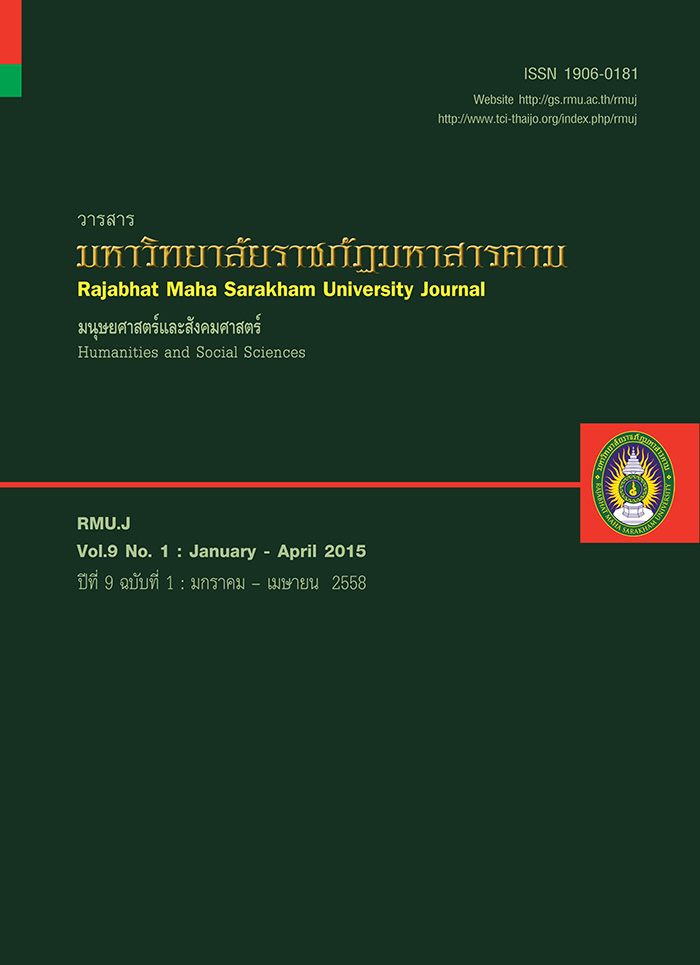การสร้างแบบทดสอบวินิจฉัยกลุ่มสาระการเรียนรู้คณิตศาสตร์ เรื่อง อสมการชั้นมัธยมศึกษาปีที่ 4;Creating the Diagnostic Mathematic Test to Explore the Problems in Inequality Learning for the First Year Higher Secondary Level Students
Main Article Content
บทคัดย่อ
การวิจัยครั้งนี้มีวัตถุประสงค์ ประการแรก เพื่อสร้างแบบทดสอบวินิจฉัยกลุ่มสาระการเรียนรู้คณิตศาสตร์ เรื่อง อสมการ
ชั้นมัธยมศึกษาปีที่ 4 ประการที่สอง เพื่อหาคุณภาพของแบบทดสอบวินิจฉัยกลุ่มสาระการเรียนรู้คณิตศาสตร์เรื่อง อสมการ
ชั้นมัธยมศึกษาปีที่ 4 และประการที่สาม เพื่อใช้ค้นหาจุดบกพร่องและสาเหตุของความบกพร่องในการเรียนวิชาคณิตศาสตร์เรื่อง อสมการ
ของนักเรียนชั้นมัธยมศึกษาปีที่ 4 จากโรงเรียนในสังกัดสำนักงานเขตพื้นที่การศึกษามัธยมศึกษา เขต 26 กลุ่มตัวอย่างที่ใช้ในการวิจัย
ครั้งนี้เป็นนักเรียนชั้นมัธยมศึกษาปีที่ 4ในสังกัดสำนักงานเขตพื้นที่การศึกษามัธยมศึกษา เขต 26 ภาคเรียนที่ 1 ปีการศึกษา 2555จำนวน
585 คนจากโรงเรียน 10โรงได้มาโดยการสุ่มแบบหลายขั้นตอน(Multi Stage Random Sampling) เครื่องมือที่ใช้ในการวิจัยครั้งนี้
คือ แบบทดสอบ 2 ฉบับ ได้แก่ฉบับที่ 1 แบบทดสอบเพื่อการสำรวจ ชนิดเติมคำและแสดงวิธีทำ แบ่งเป็นตอน 4 ตอน จำนวน 37 ข้อ
ทำการทดสอบกับนักเรียนกลุ่มตัวอย่างจำนวน 70 คน และฉบับที่ 2 แบบทดสอบวินิจฉัย ชนิดเลือกตอบ 4 ตัวเลือก ซึ่งสร้างมาจาก
แบบทดสอบเพื่อสำรวจ ทำการทดสอบ 3 ครั้ง ทดสอบครั้งที่ 1 แบบทดสอบวินิจฉัย จำนวน 37 ข้อ ไปทดสอบกับนักเรียนกลุ่มตัวอย่าง
จำนวน 80 คนพบว่า มีค่าความยากรายข้อตั้งแต่ 0.44 ถึง 0.93 ค่าอำนาจจำแนกรายข้อตั้งแต่ -0.19 ถึง 1.00ตัวลวงมีค่าค่าความยาก
รายข้อตั้งแต่ 0.00 ถึง 0.28 ค่าอำนาจจำแนกรายข้อตั้งแต่ 0.00 ถึง 0.50ได้คัดเลือกข้อสอบที่เข้าเกณฑ์ไว้จำนวน 35 ข้อ ทดสอบครั้ง
ที่ 2แบบทดสอบวินิจฉัย จำนวน 35 ข้อไปทดสอบกับนักเรียนกลุ่มตัวอย่างจำนวน 75 คนพบว่ามีค่าความยากรายข้อตั้งแต่ 0.39 ถึง
0.79 ค่าอำนาจจำแนก รายข้อตั้งแต่ 0.23 ถึง 1.00 ตัวลวงมีค่าค่าความยากรายข้อตั้งแต่ 0.05 ถึง 0.34 ค่าอำนาจจำแนกรายข้อตั้งแต่
0.05 ถึง 0.50 ค่าความเชื่อมั่นเท่ากับ 0.76 คะแนนเฉลี่ยเท่ากับ 6.60,5.45,7.33 และ 4.15 ส่วนเบี่ยงเบนมาตรฐานเท่ากับ 1.83,1.44,1.63
และ 1.12 ทดสอบครั้งที่ 3 แบบทดสอบวินิจฉัย จำนวน 35 ข้อไปทดสอบนักเรียนกลุ่มตัวอย่างจำนวน 360 คนเพื่อใช้ค้นหาจุดบกพร่อง
และสาเหตุของความบกพร่องในการเรียนคณิตศาสตร์เรื่องอสมการพบว่าจุดบกพร่องนักเรียนที่พบมากที่สุดคือ สับสนสมบัติการไม่เท่า
กัน คิดเป็นร้อยละ 32.96 บอกเครื่องหมายที่แสดงความสัมพันธ์ของอสมการไม่ครบ คิดเป็นร้อยละ 30.42 และเขียนเซตคำตอบของ
อสมการด้วยสัญกรณ์ช่วงไม่ถูกต้องคิดเป็นร้อยละ 30
This research was aimed to 1) create a quality diagnostic mathematic test about the inequalityof the
first year higher secondary level which was divided into four sections 2) find the quality of the test by considering
the reliability, validity, accuracy and precision 3) find the causes and weaknesses in learning mathematics
about the inequality. The samples in this research were 585 the first year higher secondary level students
who attended academic year 2012 from 10 secondary schools in the Educational Service Area Office 26. The
samples were grouped by using the multistage random sampling.The research tools used in the research
were two diagnostic mathematic tests. The first test was divided into 4 parts with 37 items which required
students to fill in the blanks and show the methodology used by70 students. The second diagnostic test was
created as four optional choices by selecting the answer that most students answered incorrectly on the
survey test and made the first test with 80 students to analyze the test items and improve the test.
The first experiment showed that the diagnostic test of 4 parts with 37 items had difficult values ranging
from 0.44 to 0.93. The discrimination of each item from -0.19 to 1.00. The trick had difficult values ranging
from 0.00 to 0.28 and discrimination of each item ranging from 0.00 to 0.50. Then the appropriate 35 items
of the test were selected for the second experiment.The second test was used with 75 students to find the
quality of the test in each sections and analysis of the weaknesses of the students.The second experiment
found that the diagnostic test of 4 parts with 35 items were found to have the difficult values from 0.39 to 0.79
and the discrimination of each item ranging from 0.23 to 1.00. The trick had difficult values ranging from 0.05
to 0.34 and discrimination of each item ranging from 0.05 to 0.50. The reliability was 0.76, the mean was 6.60,
5.45, 7.33 and 4.15, standard deviation was 1.83, 1.44, 1.63 and 1.12. Then test was examined in the nest
experiment. The third test was conducted with 360 students to find the quality of tests by finding the difficulty,
the discrimination, the reliability and the basic statistic and then analyze the weaknesses.The previous test
was examined in the third experiment. The results of the analysis of the weaknesses in mathematic learning
about the equality by considering the number of students who selected the answers. The results showed that
the most weakness was confusing the unequal properties representing 32.96 percent, telling incomplete
symbols of the relations of inequality representing 30.42 and writing the solution set with the incorrect notation
representing 30 percent.
Article Details
1. บทความที่ลงตีพิมพ์ทุกเรื่องได้รับการตรวจทางวิชาการโดยผู้ประเมินอิสระ ผู้ทรงคุณวุฒิ (Peer Review) สาขาที่เกี่ยวข้อง อย่างน้อย 3 ท่าน ในรูปแบบ Double blind review
2. ข้อคิดเห็นใด ๆ ของบทความที่ลงตีพิมพ์ในวารสารมหาวิทยาลัยราชภัฏมหาสารคาม นี้เป็นของผู้เขียน คณะผู้จัดทำวารสารไม่จำเป็นต้องเห็นด้วย
3. กองบรรณาธิการวารสารมหาวิทยาลัยราชภัฏมหาสารคาม ไม่สงวนสิทธิ์การคัดลอกแต่ให้อ้างอิงแสดงที่มา


